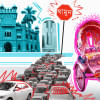Looking beyond high growth in Bangladesh

In 2018, Bangladesh began its graduation process from least developed country to developing country status. Bangladesh has now met the criteria for graduation set by the United Nations Committee for Development Policy in terms of gross national income per capita, human assets index and economic vulnerability index. Politically, the country held its 11th national elections on December 30, 2018.
During the 2018 fiscal year, the economy grew by 7.9 percent in a continuation of high growth exceeding 7 percent for the last three fiscal years. At a time when the state of the global economy looks gloomy, Bangladesh's growth numbers indicate promise. The agriculture and industry sectors saw higher growth rates than the previous year. The service sector declined slightly, though its share in GDP remained at 52.2 percent. The robust economic growth has contributed to an increase in per capita income and a reduction in poverty over time.
Yet high growth has not increased the pace of job creation and poverty reduction. According to Bangladesh's Labour Force Survey 2016–17, though the national unemployment rate is steady at only 4.2 percent, youth unemployment sat at 10.6 percent in 2017. Despite a positive demographic composition, with a large share of the country still young, Bangladesh has not been able to benefit from its "demographic dividend".
More worrying is that the youth unemployment rate is rising steadily. A significant segment of the youth population—29.8 percent in 2017—was not engaged in education, employment or training. Unfortunately, the existing education system is not providing young people with the required skills to be employable in the job market.
Linked to this is the issue of technology. Bangladesh will have to embrace technology to remain competitive in the global market. The economy must diversify and increase its productive capacity through technological upgrading and innovation. But appropriate policies need to be in place to reduce the digital divide.
The impressive growth also has not generated adequate income for all. Stark income, consumption and wealth inequalities remain a scar on the economy. Official statistics show that in 2016, the top 5 percent of households possessed 28.9 percent of the national income while the bottom 5 percent possessed only 0.2 percent.
These challenges should be addressed through higher investment in both physical and social infrastructure. Private sector investment is hovering around 23 percent of GDP. Foreign direct investment is not impressive either. The main driver of growth has been consumption. As a result, national savings declined in 2018 compared to the previous fiscal year.
The trade deficit also widened to 6.1 percent of GDP due to higher imports of food, fuel and capital goods. This is despite export and remittance growth. Export destinations of readymade garments remained concentrated in the European Union and the United States. A disproportionate share of readymade garment exports and a narrow market concentration put the export sector at risk.
The high value of the Bangladeshi taka against the US dollar put exporters at a disadvantage when it came to some of Bangladesh's competitors in the global market. China, India, Sri Lanka and Vietnam saw a depreciation of their currencies against the US dollar.
But if the real effective exchange rate is considered, the taka appreciated. There may be a need for an adjustment of the exchange rate in 2019 to increase exports. This will help reduce the deficit in the balance of payments and current account. The volume of foreign exchange reserves has been declining since 2017 and could only cover five months of imports in 2018, compared to more than eight months in the previous year.
Targets for revenue generation and expenditure efforts remain unfulfilled, reflecting a weak fiscal framework. Bangladesh's revenue-to-GDP ratio is one of the lowest in the world, at only 11.5 percent in 2018.
Bangladesh's graduation from the least developed country group will lead to the withdrawal of the European Union's and some other countries' Generalised System of Preferences schemes, meaning a loss of duty-free access to these markets. There may also be a curtailment of access to concessional finance. The newly elected government will design and execute the Eighth Five Year Plan and continue to implement the Sustainable Development Goals. Resource mobilisation will be critically important during this time.
Bangladesh has demonstrated significant success in the social sector in the past. These successes include gender parity in primary education, higher school enrolment ratios and adult literacy rates, reductions in infant mortality, under-five mortality and maternal mortality, a lower birth rate and higher life expectancy. Low allocation of budgetary resources and inequality in accessing education and health services are pertinent issues to be addressed.
Institutional and governance challenges in the banking sector in recent years are likely to threaten the macroeconomic stability of the country. Burdened with a large quantity of non-performing loans, various irregularities, a weak central bank, and problematic political influence, the sector is being supported by the government through injections of capital. It desperately needs reform and only a strong political commitment will make it happen.
While several important economic indicators show promise, Bangladeshi policymakers will have to remain vigilant to ensure that growth is sustainable and inclusive and the country's transition to developing country status is a smooth one.
Fahmida Khatun is Executive Director, Centre for Policy Dialogue (CPD). The article was originally published by East Asia Forum.










Comments